- Need Any Help: +1 647-760-5505 or
- info@trubicars.ca
The pushrod stroke of each brake chamber is critical to the proper function of a brake system. As the brakes wear, brake pushrod stroke increases. Brake wear occurs at varying rates, depending on the type of vehicle and driving conditions. To determine whether brake adjustment is correct, the pushrod stroke must be inspected at least daily. When the brake pushrod stroke exceeds the adjustment limit, the brake is out of adjustment.
Brake pushrod stroke must comply with the Ontario Highway Traffic Act and regulations. Each air brake chamber’s pushrod stroke must not exceed the specified adjustment limits.
Since adjustment limits vary depending on the size and type of air brake chamber, you must be able to identify the particular brake chamber in use. Brake chamber size can be determined by measuring the diameter of the clamp used to hold it together or by locating the size markings on the brake chamber.
The most common brake chamber size is 30. However, there are vehicles using both smaller and larger sizes. For example, sizes 16, 20, 24 and 36 brake chambers may be used.
Measuring the diameter of brake chambers requires a special tool. Locating and reading the size markings on a brake chamber may require removing dirt, corrosion and paint from the surfaces.
You are most likely to determine the size of the brake chambers on any vehicle through your employer or the vehicle owner’s manual. This will avoid the need to measure a brake chamber or locate size markings. The type of brake chamber also affects the specified brake adjustment limit, which can vary by 19 millimeters or more between standard and long-stroke brake chambers. Long-stroke brake chambers can be identified by three visible characteristics:
The most visible and permanent of the markings used to identify long-stroke brake chambers are the square ports. Standard brake chambers have round ports.
It is critical to use correct inspection methods to obtain reliable inspection results. The most reliable method for inspecting brake adjustment is to measure the applied pushrod stroke.
It is important to note that the body design and suspension of some vehicles may limit safe access to certain brake components unless the vehicle is supported on a hoist or is over a pit or ramp. Also, some brake systems have covers or housings that conceal the brake linkage, making it impossible to inspect brake adjustment using the techniques described here.
| Secure the vehicle with wheel chocks or blocks | 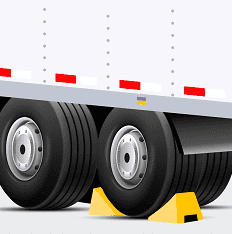 |
| Ensure air pressure is above 621 kPa (90 psi) and release the spring brakes. | 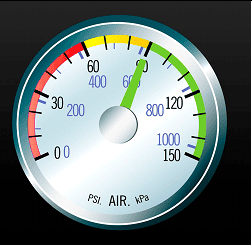 |
| Select one of the following methods:
Method 1: |
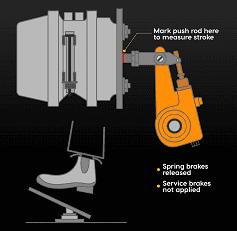 |
| Method 2: Measure the released position of the pushrod. Measure and note the distance from a point on the pushrod to a suitable fixed point at the brake chamber. This is Measurement 1. |
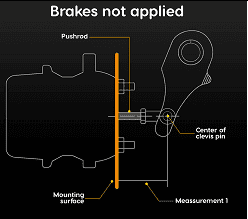 |
| Raise or lower the air pressure by running the engine or pumping the brake pedal until both the primary and secondary air-tank gauges display 621 to 690 kPa (90 to 100 psi). | 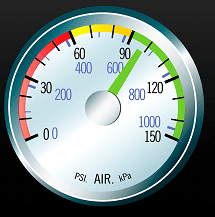 |
| Shut off the engine. | 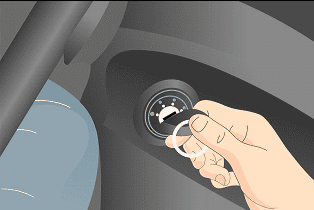 |
| Press and hold the brake pedal in the fully applied position. | 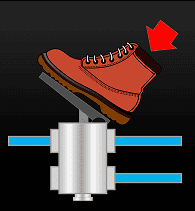 |
| Method 1: Measure the distance from the brake chamber or fixed reference point to the mark on the pushrod. |
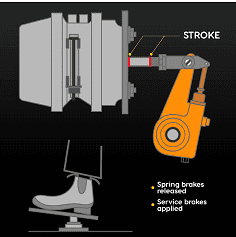 |
| Method 2: Measure the applied position of the pushrod. Remeasure and note the distance from the previously selected point on the pushrod to the previously selected fixed point at the brake chamber. This is measurement number 2. Subtract measurement 1 from measurement 2 to calculate the applied pushrod stroke measurement. |
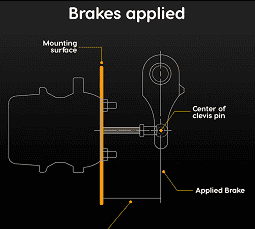 |
| Determine the number size (such as 16, 20, 24 or 30) and type (such as standard or long-stroke) of the brake chamber. | 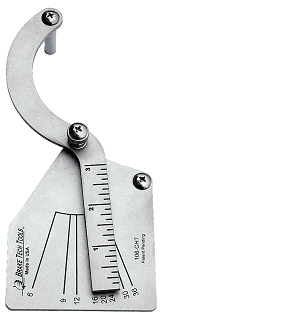 |
| Determine the adjustment limit for the brake chamber. | 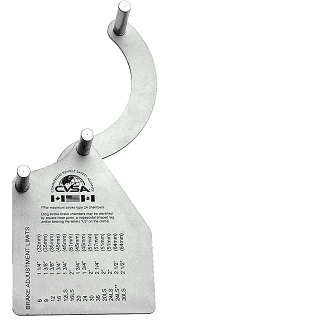 |
| Compare the applied pushrod stroke to the applicable adjustment limit and identify any brake that exceeds the adjustment limit as defective. |
Note: All drivers are required to demonstrate an applied pushrod-stroke measurement method for inspecting brake adjustment as part of the Ministry of Transportation air brake endorsement practical examination.
Brake stroke indicators are visual tools used to measure and monitor the movement of the brake pushrod in air brake systems. These indicators fit onto the brake linkage and fixed reference points near the brake linkage to provide a visual indication of the applied pushrod stroke. By using brake stroke indicators, drivers and maintenance personnel can efficiently check brake adjustment and identify potential issues without the need to get under the vehicle in many cases.
Prepare the Vehicle:
|
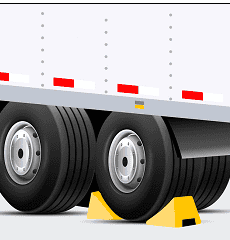 |
Release Air Pressure:
|
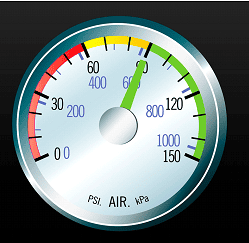 |
Locate the Brake Chambers:
|
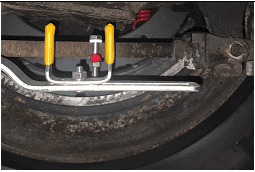 |
Ensure Proper Installation:
|
|
Apply the Brakes:
|
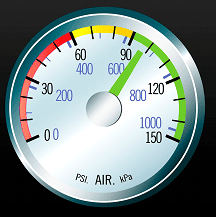 |
Observe the Indicators:
|
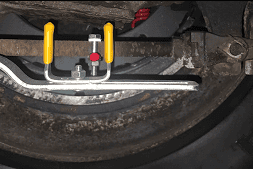 |
Determine Brake Adjustment:
|
|
Adjust Brakes if Necessary:
|
|
Re-check After Adjustment:
|
|
Final Steps:
|
Automatic slack adjusters, also known as automatic brake adjusters, are mechanical devices designed to maintain the proper clearance between the brake shoes and the drum in air brake systems. They automatically adjust the brake stroke as the brake linings wear, reducing the need for frequent manual adjustments. When properly installed and maintained, automatic slack adjusters are highly reliable and help ensure consistent braking performance.
Despite the advantages of automatic slack adjusters, regular inspection of brake adjustment is still necessary. Both automatic and manual slack adjusters require periodic checks to ensure they function correctly and maintain proper brake adjustment.
When brakes with manual slack adjusters are out of adjustment, they must be readjusted so that the pushrod stroke is less than the adjustment limit. Only certified technicians may repair and perform brake re-adjustments on manual slack adjusters. In Ontario, drivers can become certified to perform brake re-adjustments on manual slack adjusters. Only those who have obtained certification are permitted to perform brake re-adjustments. This certification does not permit you to manually re-adjust automatic slack adjusters.
Automatic slack adjusters, if they are working properly, do not require regular readjustment. If periodic re-adjustments are required, it means that the automatic slack adjuster is defective and must be repaired by a certified technician. Only certified technicians are permitted to perform re-adjustments or repairs on automatic slack adjustors. It is dangerous for someone who is not certified to attempt to adjust the automatic slack adjustors. You may unknowingly damage the brake and cause it to malfunction. Check your automatic slack adjusters often to ensure that the adjustments are correct; however, do not attempt to repair them yourself.
Important: The Ontario Highway Traffic Act and regulations prohibit the operation of a vehicle with a brake that is out of adjustment.
An air brake system is a critical component of heavy vehicles, ensuring safe and effective braking performance. The Ontario Highway Traffic Act and its regulations strictly prohibit the driving or operation of a vehicle on a highway if its air brake system is defective. This legal framework emphasizes the importance of maintaining a fully functional brake system to ensure road safety.